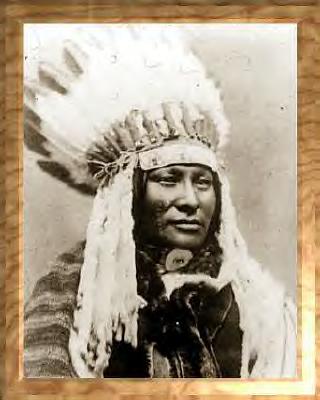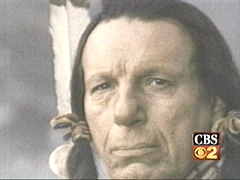

It's a literally romantic notion to see Native people dying.
Chris Eyre, quoted in Eyre Talks of New Movie, Hollywood Stereotypes, Reznet News, 12/07
Why Americans romanticize Indians
Art: Review: Vanishing Frontier
Cincinnati Art Museum explores American Indian imagery
BY Tamera Lenz Muente | Posted 11/05/2007
"And now ... the frontier has gone, and with its going has closed the first period of American history," declared historian Frederick Jackson Turner in a speech at the 1893 Columbian Exposition in Chicago. His statement shocked the American public. For decades, the American identity had been wrapped up in exploration and westward expansion. What would it mean to be American now that the frontier had been conquered?
Artists had already been addressing that question, and much artwork exhibited at the Columbian Exposition — the world's fair of industry and the arts — provided the answer. The American Indian — specifically, the noble, resolute Plains Indian living in harmony with nature — became the emblem of all that late-19th-century Americans suddenly realized they had lost.
This sense of loss provides the guiding theme of Vanishing Frontier: Rookwood, Farny, and the American Indian, now on view at the Cincinnati Art Museum (CAM). The multi-faceted exhibition brings together 52 Rookwood ceramics, 40 paintings by Henry Farny and 35 American Indian artifacts, all of which come either from private collections or the buried storage rooms of the CAM. Reproductions of photographs used as sources for the artwork give further context.
Like so much American history, the romantic notion of the noble Indian at the end of the 19th century smacked of hypocrisy. Prior to this period, whites feared the American Indians, brought disease and destruction to their way of life, drove them off their lands to reservations, forced Christianity on them and sent their children away to boarding schools. Once the mêlée was over, American consumers appeased their guilt by purchasing idyllic pictures of the culture they had decimated.
Why the romanticizing continues
From Exile on Main Street: Home of the Brave by Paul Chaat Smith:
I can't help thinking of Vine Deloria Jr., a Lakota and one of our best intellectuals. In 1969 he wrote Custer Died For Your Sins, a tough, funny book with the subtitle "An Indian Manifesto." Fortunate timing helped make it a best-seller. It was at the crest of the original Red Power movement of the 1960s: there were hunt-ins, fish-ins and the occupation of Alcatraz Island. The Unjust Society, by Harold Cardinal, a Canadian Indian, and Stan Steiner's The New Indians seemed certain to be the first of a new wave of books about our current situation. But something else happened. Americans became fascinated with Indians all right, but not the ones still here. Instead, Americans turned to Touch the Earth, a sepia-toned volume of famous chiefs greatest rhetorical hits. They read The Memoirs of Chief Red Fox, by a living Sioux chief no living Sioux had ever heard of. Chief Red Fox claimed to have personally witnessed the Battle of Little Big Horn. (This book was quickly revealed to be fake, but only after it sold more than any serious book about Indians ever had.) And, of course, the mother of all Indian books, Bury My Heart at Wounded Knee, an entirely reasonable history of Indians that ends in 1890, without even a hint that some of us survived.
Well, all of this blew Deloria's mind, and in 1973 he drew this analogy. Imagine it's 1955, right after the landmark Brown vs. Board of Education Supreme Court ruling on desegregation, in the midst of the Montgomery bus boycott. Martin Luther King holds a press conference, but it's a disaster; all the reporters ask about are about the old days on the plantation and the origin of Negro spirituals. The freedom struggle pushes on, undaunted. Americans are transfixed by these dramatic events, and rush out to buy new books on the cultural achievements of Africa in 1300. Two new Black writers, James Baldwin and LeRoi Jones publish important books, but they're ignored in favor of a new history called Bury My Heart at Jamestown. People are terribly moved. Deloria continues, "People reading the book vow never again to buy or sell slaves." Considering that we have just lived through over twenty years of the most significant Indian political movement in a century, including much new sensitivity and education, we might have thought things had improved. But the familiarity of the situation around these recent publications leaves me feeling things haven't gotten any better, only more subtle. The discourse on Indian art or politics or culture, even among people of good will, is consistently frustrated by the distinctive type of racism that confronts Indians today. This romanticism. Simply put, romanticism is a highly developed, deeply ideological system of racism towards Indians that encompasses language, culture, and history. From the beginning of this history the specialized vocabulary created by Europeans for "Indians" ensured our status as strange and primitive. Our political leaders might have been called kings or lords, instead they were chiefs. Indian religious leaders could have just as accurately been called bishop or minister, instead they were medicine men. Instead of soldier or fighter, warrior. And, perhaps, most significantly, tribe instead of nation. (For a more recent example of this, note how most press accounts often talk about ethnic troubles in Europe, but tribal conflicts in Southern Africa.) Mao Tse Tung and Beethoven are not translated from Chinese and French, language became and remains a tool by which we are made the "Other;" the Lakota name Tatonka Iotanka becomes Sitting Bull.
This is not to say that bishop was necessarily more accurate than medicine man, or that we have not made a term like warrior our own, or that translated Indian names aren't beautiful. It is to recognize that there are political implications to those decisions, and it was not one of multicultural understanding. The language exoticises and this exoticization has encompassed and permitted a range of historical responses from destruction to idealization.
Because our numbers are so few, the battle for a more realistic and positive treatment in the mass media has always been a necessary component of our struggle. The new traditionalism that does exist in Indian Country was won at great expense and effort. It was only fifty years ago that Indian languages and ceremonies were discouraged and in many cases outlawed.

More on unrealistic images
Filmmaker Chris Eyre (Cheyenne/Arapaho) made similar points at the Taos Talking Pictures festival. From Indian Country Today, 4/20/02:
"Second to religion, I think movies have been the most damaging thing to Indians," said Chris Eyre. "In 100 years of cinema there aren't portrayals of Indians as people. Indians will watch bad images of Indians because they are so starved of images of themselves. It's not about looking at Hollywood studios and saying 'I hope they are going to get it.' It's about us demanding it. I'm not against non-Indians making movies about Indians. It's just there's never a balance."
Romanticized New Age portrayals, such as "Dances with Wolves," also came under fire.
"It's manufactured. There's Indian country, and that I know. Then there are Native Americans wearing dreamcatchers. They're not people I know," commented Eyre.
Comment: Other examples of romanticized Indians include team names and mascots, military craft named after Indians, and chiefs, warriors, and maidens on Indian products.
Indians like romanticized Indians too
Why do many Indian love old Westerns like The Searchers and support sports teams with Indian mascots? From Exile on Main Street: Home of the Brave by Paul Chaat Smith:
Twenty years ago it was enough to denounce silly books and movies about Indians but today that almost misses the point. What's different about our present situation is that it's become clear that we as Indian people love these books and the images they present as much as anyone else. In fact, both Little Tree and Brother Eagle, Sister Sky will probably find their way under many Indian Christmas trees and the fact of their authorship will not greatly affect their promising future with Indian readers any more than it will with non-Indian readers.
Related links
Romancing the Indian: sentimentalizing and demonizing in Cooper and Twain
Spirit and the noble savage
Uncivilized Indians
|
. . . |

|
All material © copyright its original owners, except where noted.
Original text and pictures © copyright 2007 by Robert Schmidt.
Copyrighted material is posted under the Fair Use provision of the Copyright Act,
which allows copying for nonprofit educational uses including criticism and commentary.
Comments sent to the publisher become the property of Blue Corn Comics
and may be used in other postings without permission.